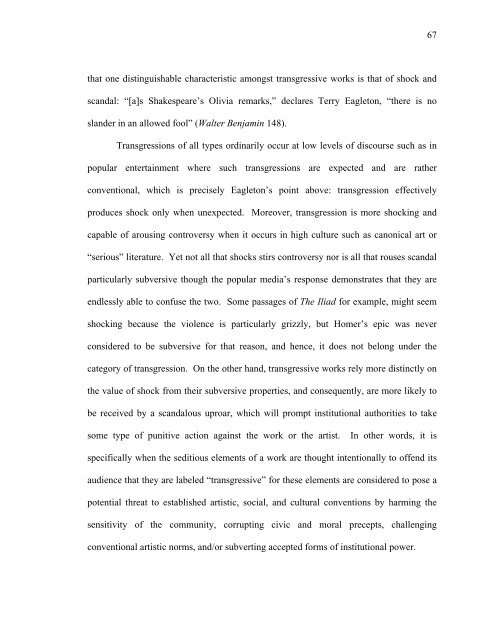Untitled - Sexey's School Moodle
Untitled - Sexey's School Moodle
Untitled - Sexey's School Moodle
Create successful ePaper yourself
Turn your PDF publications into a flip-book with our unique Google optimized e-Paper software.
that one distinguishable characteristic amongst transgressive works is that of shock and<br />
scandal: “[a]s Shakespeare’s Olivia remarks,” declares Terry Eagleton, “there is no<br />
slander in an allowed fool” (Walter Benjamin 148).<br />
Transgressions of all types ordinarily occur at low levels of discourse such as in<br />
popular entertainment where such transgressions are expected and are rather<br />
conventional, which is precisely Eagleton’s point above: transgression effectively<br />
produces shock only when unexpected. Moreover, transgression is more shocking and<br />
capable of arousing controversy when it occurs in high culture such as canonical art or<br />
“serious” literature. Yet not all that shocks stirs controversy nor is all that rouses scandal<br />
particularly subversive though the popular media’s response demonstrates that they are<br />
endlessly able to confuse the two. Some passages of The Iliad for example, might seem<br />
shocking because the violence is particularly grizzly, but Homer’s epic was never<br />
considered to be subversive for that reason, and hence, it does not belong under the<br />
category of transgression. On the other hand, transgressive works rely more distinctly on<br />
the value of shock from their subversive properties, and consequently, are more likely to<br />
be received by a scandalous uproar, which will prompt institutional authorities to take<br />
some type of punitive action against the work or the artist. In other words, it is<br />
specifically when the seditious elements of a work are thought intentionally to offend its<br />
audience that they are labeled “transgressive” for these elements are considered to pose a<br />
potential threat to established artistic, social, and cultural conventions by harming the<br />
sensitivity of the community, corrupting civic and moral precepts, challenging<br />
conventional artistic norms, and/or subverting accepted forms of institutional power.<br />
67



